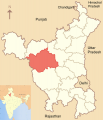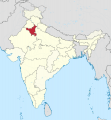Rakhigarhi
Da Ufopedia.
(Creata pagina con ''''Rakhigarhi''', or '''Rakhi Garhi''', is a village in Hisar District in the northwest Indian state of Haryana, around 150 kilometers from Delhi. It lies on the …') |
(→Galleria immagini) |
||
| (6 revisioni intermedie non mostrate.) | |||
| Riga 1: | Riga 1: | ||
| + | {{Tradurre}} | ||
'''Rakhigarhi''', or '''Rakhi Garhi''', is a village in [[Hisar District]] in the northwest [[India]]n state of [[Haryana]], around 150 kilometers from [[Delhi]]. It lies on the Chautang River. In 1963 [[archeologist]]s discovered the village was the site of an extensive city, part of the [[Indus Valley Civilization]]. Since 1997 the [[Archaeological Survey of India]] has undertaken a detailed excavation of the site, revealing the size of the lost city (at least 2.2 km²) and recovering numerous artifacts, some over 5,000 years old. Evidence of paved roads, drainage system, large rainwater collection, storage system, [[terracotta]] brick, statue production, and skilled metal working (in both [[bronze]] and precious metals) has been uncovered. [[Jewellery]], including bangles made from terracotta, [[conch]] shells, [[gold]], and semi-precious stones, have also been found. | '''Rakhigarhi''', or '''Rakhi Garhi''', is a village in [[Hisar District]] in the northwest [[India]]n state of [[Haryana]], around 150 kilometers from [[Delhi]]. It lies on the Chautang River. In 1963 [[archeologist]]s discovered the village was the site of an extensive city, part of the [[Indus Valley Civilization]]. Since 1997 the [[Archaeological Survey of India]] has undertaken a detailed excavation of the site, revealing the size of the lost city (at least 2.2 km²) and recovering numerous artifacts, some over 5,000 years old. Evidence of paved roads, drainage system, large rainwater collection, storage system, [[terracotta]] brick, statue production, and skilled metal working (in both [[bronze]] and precious metals) has been uncovered. [[Jewellery]], including bangles made from terracotta, [[conch]] shells, [[gold]], and semi-precious stones, have also been found. | ||
| Riga 12: | Riga 13: | ||
Mr. Wazir Chand Saroae, a local schoolteacher and a resident of Rakhi Garhi, has done his best to preserve what he can of Rakhigarhi's anitquities. He has an invaluable collection of Indus valley artefacts. He has donated much of his collection to the National Museum; he has the rest in his little house in Rakhigarhi. | Mr. Wazir Chand Saroae, a local schoolteacher and a resident of Rakhi Garhi, has done his best to preserve what he can of Rakhigarhi's anitquities. He has an invaluable collection of Indus valley artefacts. He has donated much of his collection to the National Museum; he has the rest in his little house in Rakhigarhi. | ||
| + | ==Galleria immagini== | ||
| + | <gallery> | ||
| + | Immagine:HaryanaHisar.png | ||
| + | Immagine:Haryana_in_India_28disputed_hatched29_svg.png | ||
| + | Immagine:Government_of_Haryana_seal.jpg | ||
| + | Immagine:Flag of India.svg.png | ||
| + | Immagine:Flag of the United Nations svg.png | ||
| + | </gallery> | ||
== References == | == References == | ||
| Riga 23: | Riga 32: | ||
* [http://www.geocities.com/churud.geo/rakhigarhi.html Journey to the unknown civilisation, photos and artifacts] | * [http://www.geocities.com/churud.geo/rakhigarhi.html Journey to the unknown civilisation, photos and artifacts] | ||
| - | [[Categoria: | + | https://it.wikipedia.org/wiki/Distretto_di_Hisar |
| + | |||
| + | https://it.wikipedia.org/wiki/Divisione_di_Hisar | ||
| + | |||
| + | https://it.wikipedia.org/wiki/Haryana | ||
| + | [[Categoria:Città della civiltà della valle dell'Indo]] | ||
Versione attuale delle 10:39, 4 lug 2013
| Questa voce ha bisogno di essere tradotta. |
Rakhigarhi, or Rakhi Garhi, is a village in Hisar District in the northwest Indian state of Haryana, around 150 kilometers from Delhi. It lies on the Chautang River. In 1963 archeologists discovered the village was the site of an extensive city, part of the Indus Valley Civilization. Since 1997 the Archaeological Survey of India has undertaken a detailed excavation of the site, revealing the size of the lost city (at least 2.2 km²) and recovering numerous artifacts, some over 5,000 years old. Evidence of paved roads, drainage system, large rainwater collection, storage system, terracotta brick, statue production, and skilled metal working (in both bronze and precious metals) has been uncovered. Jewellery, including bangles made from terracotta, conch shells, gold, and semi-precious stones, have also been found.
It is 224 hectares, the largest in the country. In size, dimensions strategic location and unique significance of the settlement, Rakhi Garhi matches Harappa and Mohenjodaro at every level. Three layers of Early, Mature and Late phases of Indus Valley civilization have been found at Rakhi Garhi. What has so far been found indicates that Rakhi Garhi settlement witnessed all the three phases.
The site’s antiquities, drainage system and signs of small-scale industry are in continuity with other Indus sites.
Digging so far reveals a well planned city with 1.92 m wide roads, a bit wider than in Kalibangan. The pottery is similar to Kalibangan and Banawali. Pits surrounded by walls have been found, which are thought to be sacrificial pits or for some religious ceremonies. Which shows fire was used extensively in their religious ceremonies. There are brick lined drains to handle sullage from the houses. Among other things that have been found are, terracotta statues, weights, bronze artifacts, combs, needles and terracotta seals. A bronze vessel has been found which is decorated with gold and silver. A gold foundry with about 3000 unpolished semi-precious stones has been found. Many tools used for polishing these stones and a furnace were found there. A burial site has been found with 11 skeletons with their heads in the north direction. Near the heads of these skeletons, utensils for everyday use are kept. The three female skeletons have shell bangles on their left wrists. Near one female skeleton, a gold armlet has been fond. In addition semi precious stones have been found lying near the head, showing that they were part of some sort of necklace.
The site has trick deposits of ‘Hakra Ware’ (typical of settlements dating back before the early phases of Indus Valley). It also has ‘Early and ‘Mature’ Harappan artifacts. The solid presence of the Hakra Ware culture raises the important question: "Did the Indus civilization come later than it is recorded?" The Hakra and the Early phases are separated by more than 500-600 years and the Hakra people are considered to be the earliest Indus inhabitants. Although the carbon-14 dating results are awaited, based on the thick layers of Hakra Ware at Rakhi Garhi, it is said that the site may date back to about 2500 BC to 3000 BC. This pushes the Indus Valley civilization history by a thousand years or more.
Present day Rakhigarhi is a muddy village with heaps of cowdung, muddy roads and uncovered sewage drains. It is unfortunate that while 5000 years ago, the residents of Rakhi Garhi enjoyed the privileges of urban life - paved roads and streets, undergroung sewerage system, rainwater harvesting system, toilets and bathing facilities - the modern dwellers at the place live in a muddy village with poor bath and sanitation facilities. Bits of black plastic show the excavation area. We learned that the Archeological Survey of India excavated the place for three winters, starting from 1997. But there was not a single sign, not a single attempt to indicate the importance of the place to the visitors. Apparently, the excavation has been stopped for years because of a CBI investigation on the misuse of funds.
Mr. Wazir Chand Saroae, a local schoolteacher and a resident of Rakhi Garhi, has done his best to preserve what he can of Rakhigarhi's anitquities. He has an invaluable collection of Indus valley artefacts. He has donated much of his collection to the National Museum; he has the rest in his little house in Rakhigarhi.
Galleria immagini
References
- Lal, B.B. (2002) The Sarasvati flows on.
External links
- Archaeology at Rakhi Garhi
- More information about the dig at Rakhi Garhi
- Photos of site and of recovered artifacts
- Journey to the unknown civilisation, photos and artifacts
https://it.wikipedia.org/wiki/Distretto_di_Hisar




